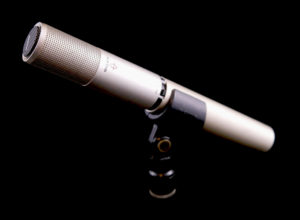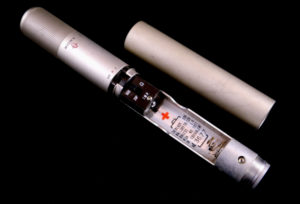Here’s a little break from the usual high-tech talk. Since my microphone collection shows up in studio photos every now and then, I thought I’d describe each of the mics on the shelf and their significance. These are older microphones that I have for display purposes, some are functional and some are not. This is different from my “Mic Locker” which are the microphones I actually use for recording. I collected most of these years ago when cheap old microphones were easy to find at flea markets.

Electro-VoIce 726 Cardyne I Microphone – This is a uni-directional dynamic microphone from the late 1940s. It’s similar in size to the Shure 556 “fat boy” microphone, and likely was Electro-Voice’s competitive answer to that microphone. (More Information)
Electro-VoIce V2 Ribbon Microphone – Unfortunately the nameplate is missing on this microphone so I can’t make a firm identification. I have verified that it is a ribbon by disassembling it.
Shure 556B Unidyne I microphone – This is Shure’s Unidyne I, Model 556B “Fatboy” microphone that I bought at a flea-market, probably about 20 years ago. It was one of the original Unidyne, 55 series mikes, and I bought it mostly for decorative purposes. This one works, but the response is rather thin. I have another working one that we use occasionally. (More Information)
Shure 55S – This is an old working Shure 55S Unidyne II microphone. It is smaller than the original Model 55 (and 556B) The Shure 55S, often called the “Elvis Microphone” is without a doubt the most iconic microphone ever made. Shure still manufactures them, although equipped with their latest Unidyne III cartridge.
Shure Cardiline 644 Sound Spot Shotgun Dynamic Microphone – This is a highly directional dynamic often used on a boom in early TV broadcasting. This one is non-working, but I have a gray non-reflective one as would be used on a set that works well.
Turner 598 – This was a popular PA microphone from the 1960s. This model was the first microphone that I ever repaired. I used to set up sound for assemblies in High School and we had a broken 598. I opened it up and found that the wire from the voice coil to the transformer had broken. Somehow I affected a repair on that thin wire with my trusty Wen 100 soldering gun and the mic was back in service.
Lafayette PA46 Dynamic – This model of microphone was the first one I ever owned. My parents bought it for me to go with my Lafayette tape deck in the early 1960s. The mics were a Japanese import and sold under several brand names. The mic came with a bad capsule, but I found another with a good capsule and corroded body and replaced the capsule in this one and now it is a working microphone.
Turner 99 – The Turner 99 was their most rugged Dynamic microphone of the 1940s. I t was used wherever a microphone was needed that would stand up to abuse. There is no special significance to me other than that it is another classic microphone from the 1940s.
Sony ECM-22P – This is an electret condenser microphone from the early 1970s. This was one of the first condenser microphones I bought. I have four of them and they all still work. (More Information)
Astatic JT-31 – This is an inexpensive crystal microphone made in the 1940s by Astatic Corp. which is now CAD. This microphone has become a favorite for blues harp players and one in working order will fetch a good price. The crystal element has decayed in this one and it is for display only.
Kellogg T-48-C Carbon Microphone – This was a communications microphone, possibly military, from the early 1940s. This is likely the oldest microphone that I own. Carbon microphones were used originally for telephone communications and then for broadcasting in the early days of radio. In the late 1960s, between high school and college, I worked at a ship-to-shore radio station, WMI, in my hometown of Lorain, Ohio. All of the operator positions used microphones similar to this one as the operators provided communication to all of the ships on the Great Lakes in the days before satellite and cell phone communications.


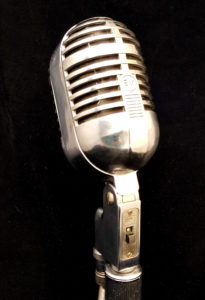
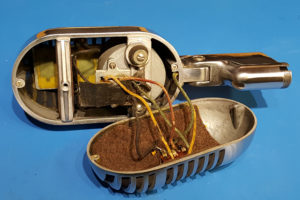
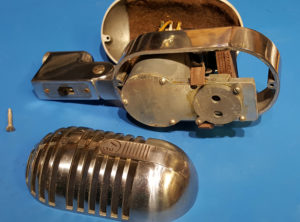
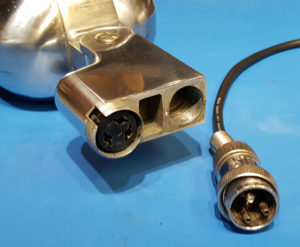

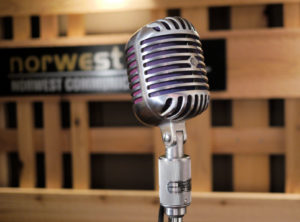 I’m starting to organize some of the stuff I brought from the old studio and found this old Shure Model 556B “Fatboy” microphone that I bought at a flea-market, probably about 15 years ago.
I’m starting to organize some of the stuff I brought from the old studio and found this old Shure Model 556B “Fatboy” microphone that I bought at a flea-market, probably about 15 years ago. 